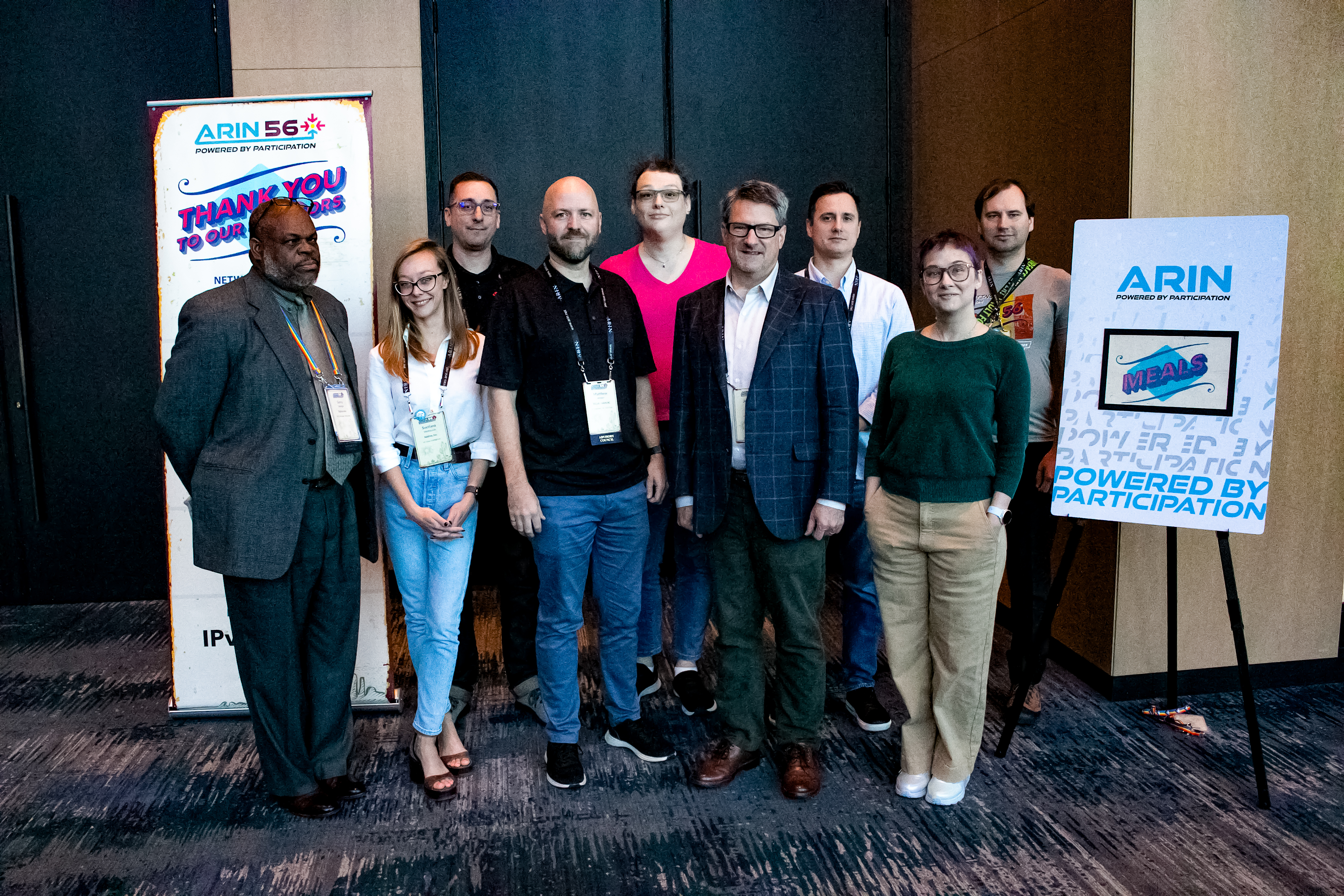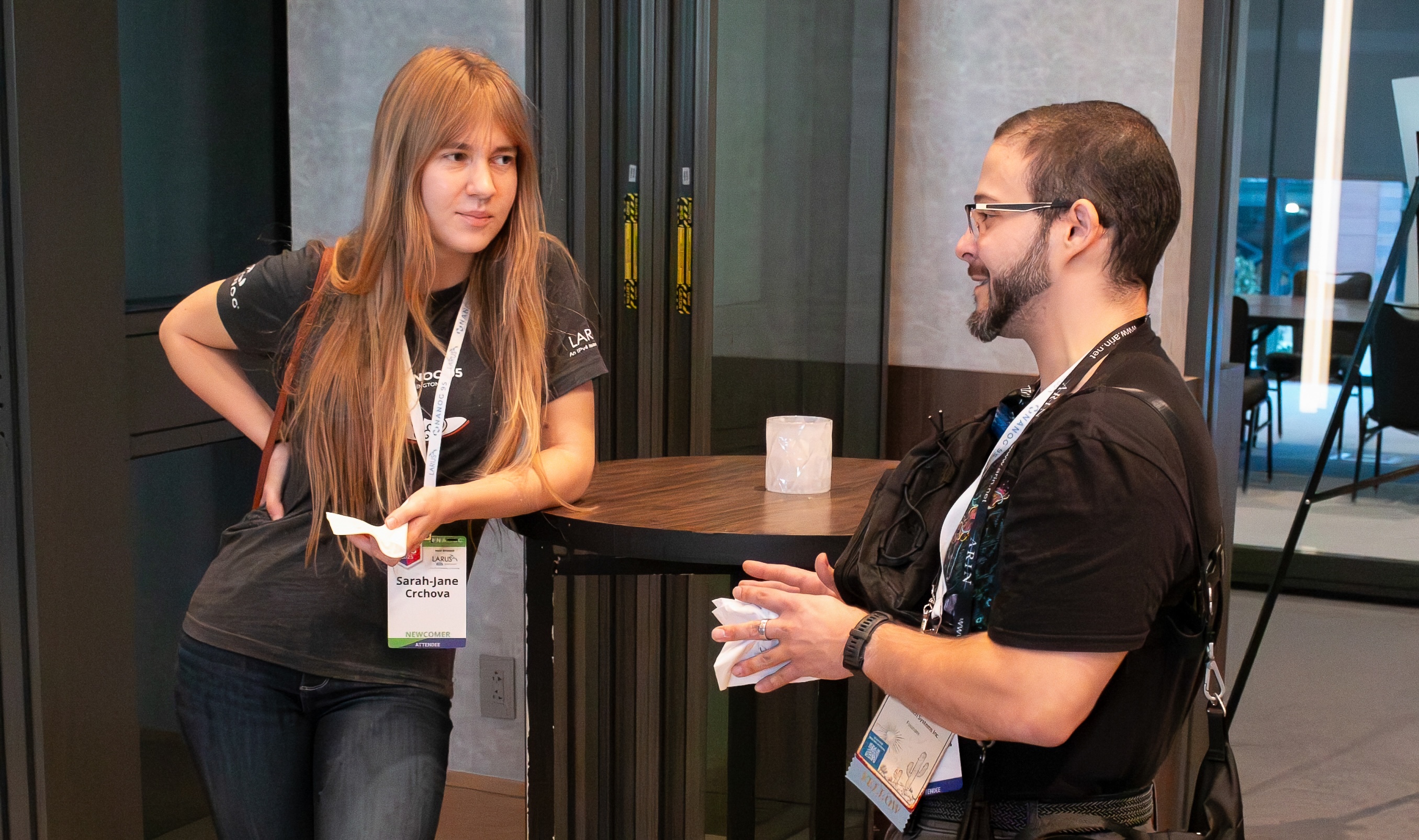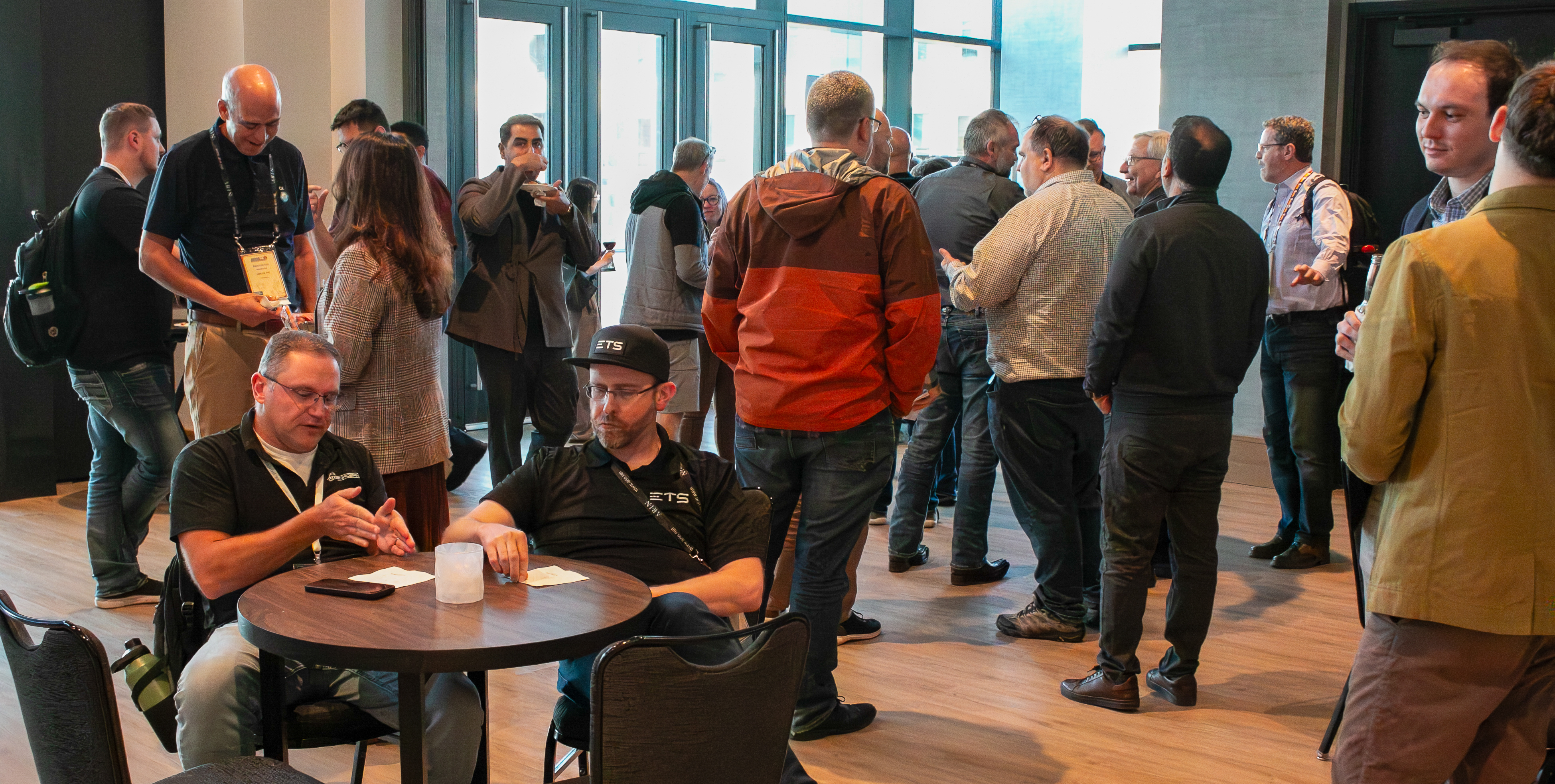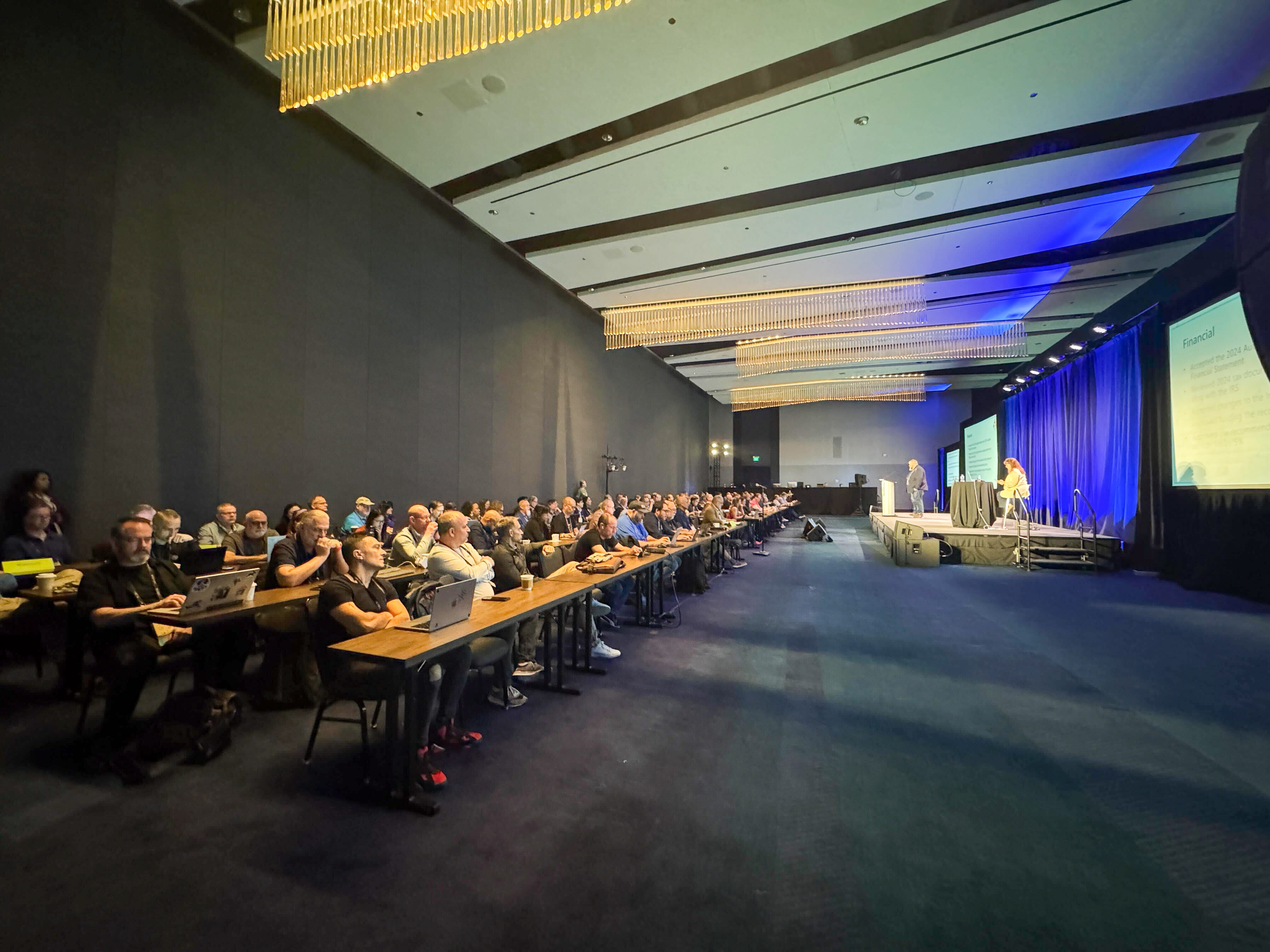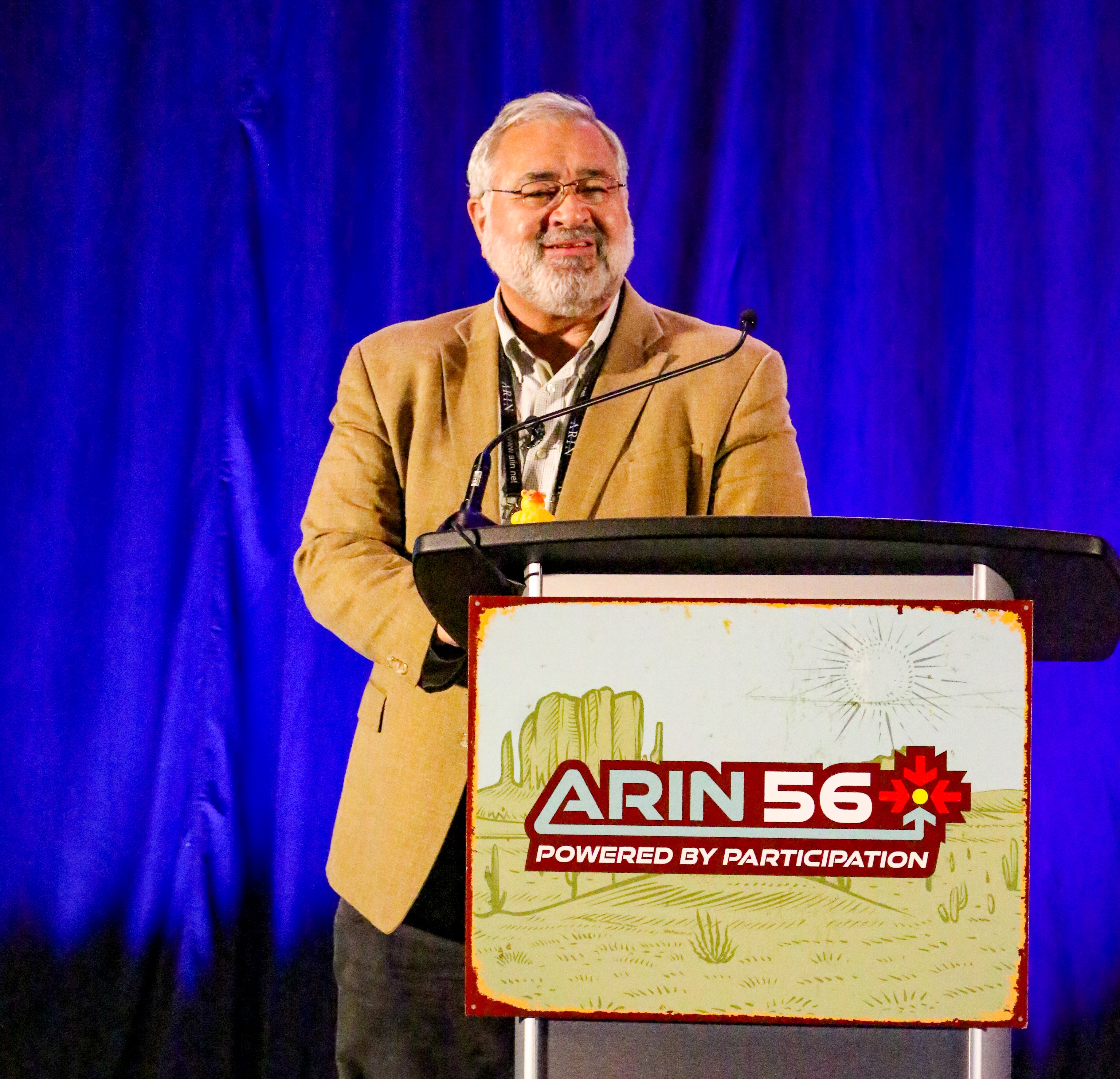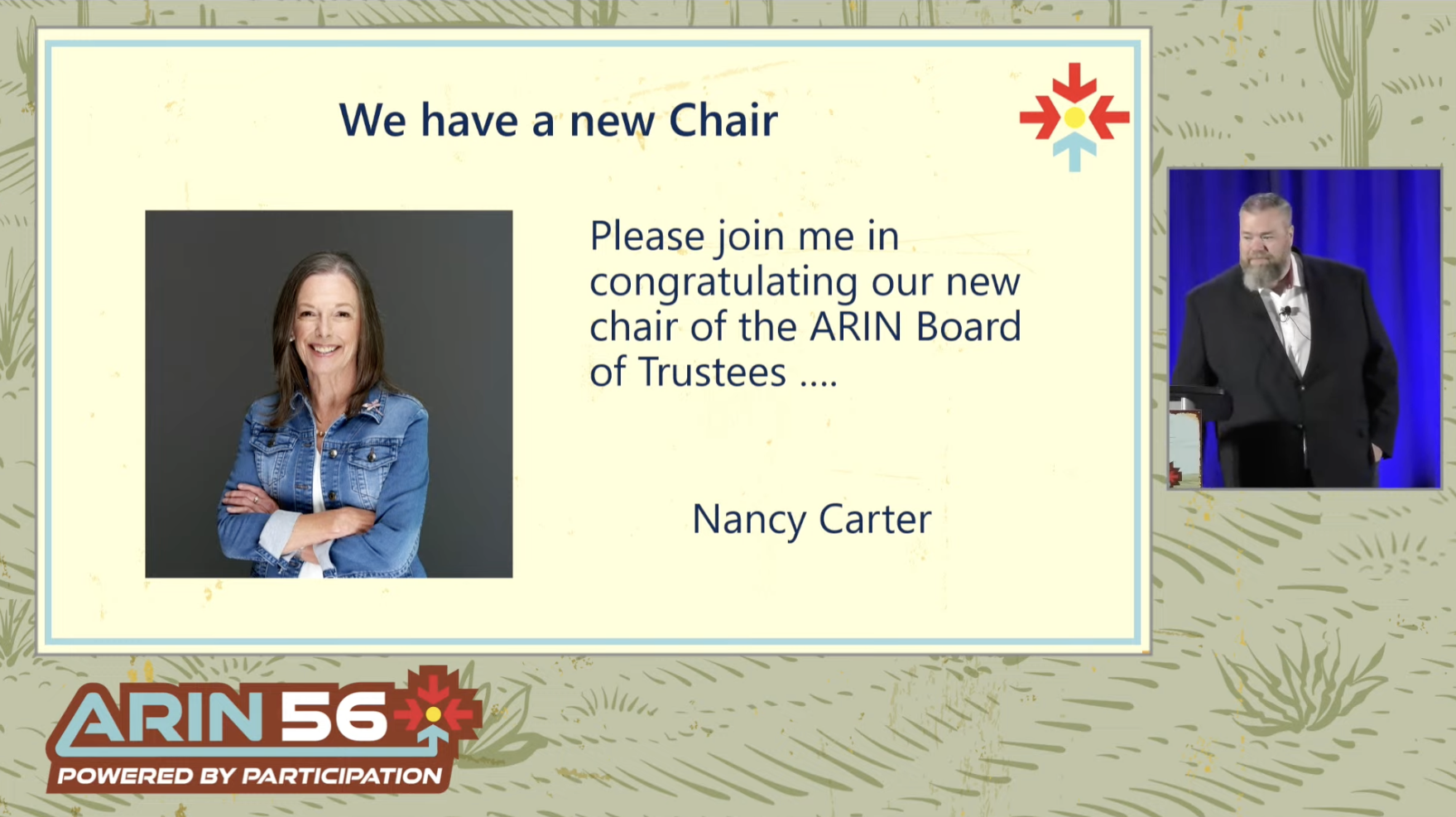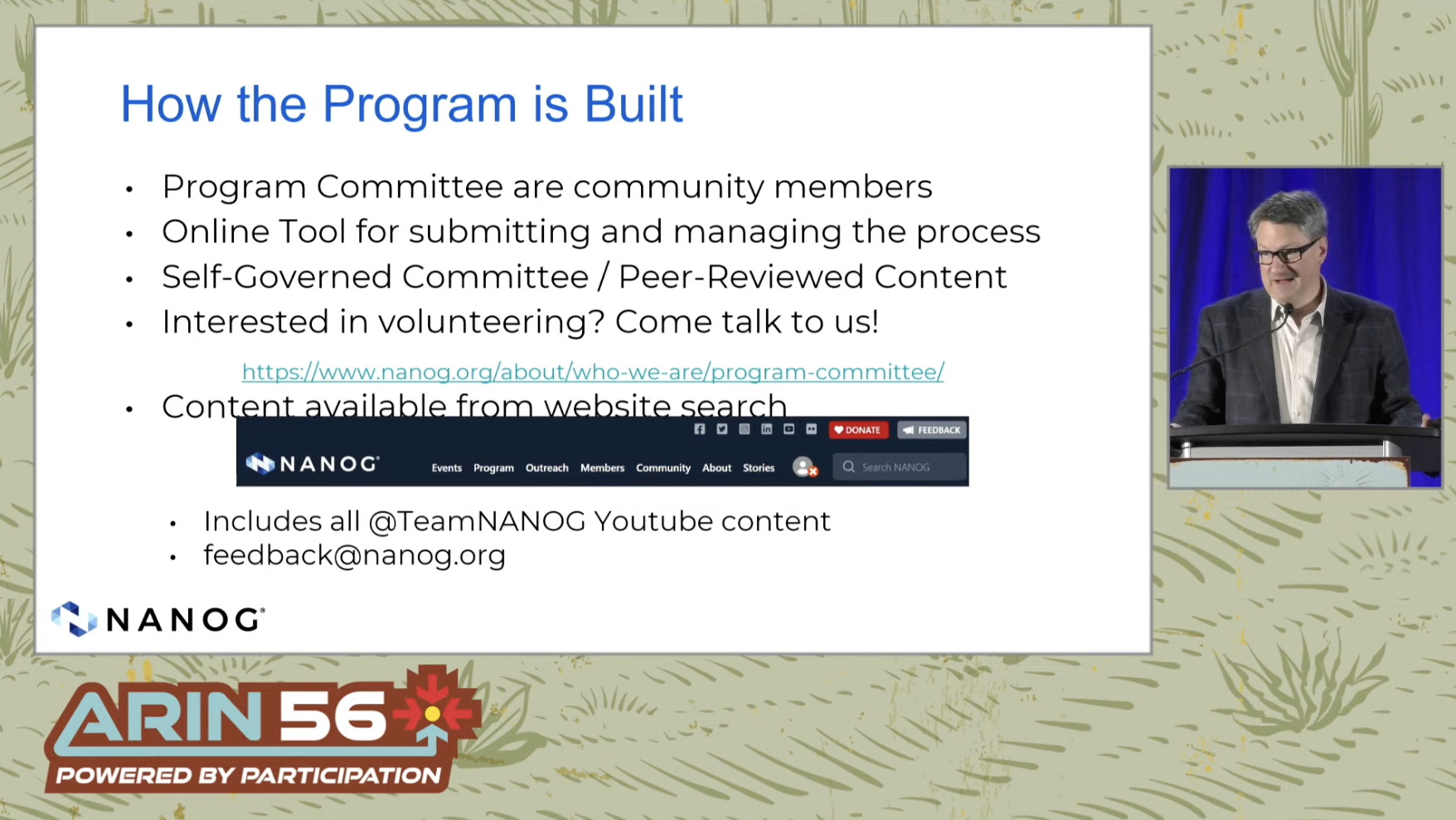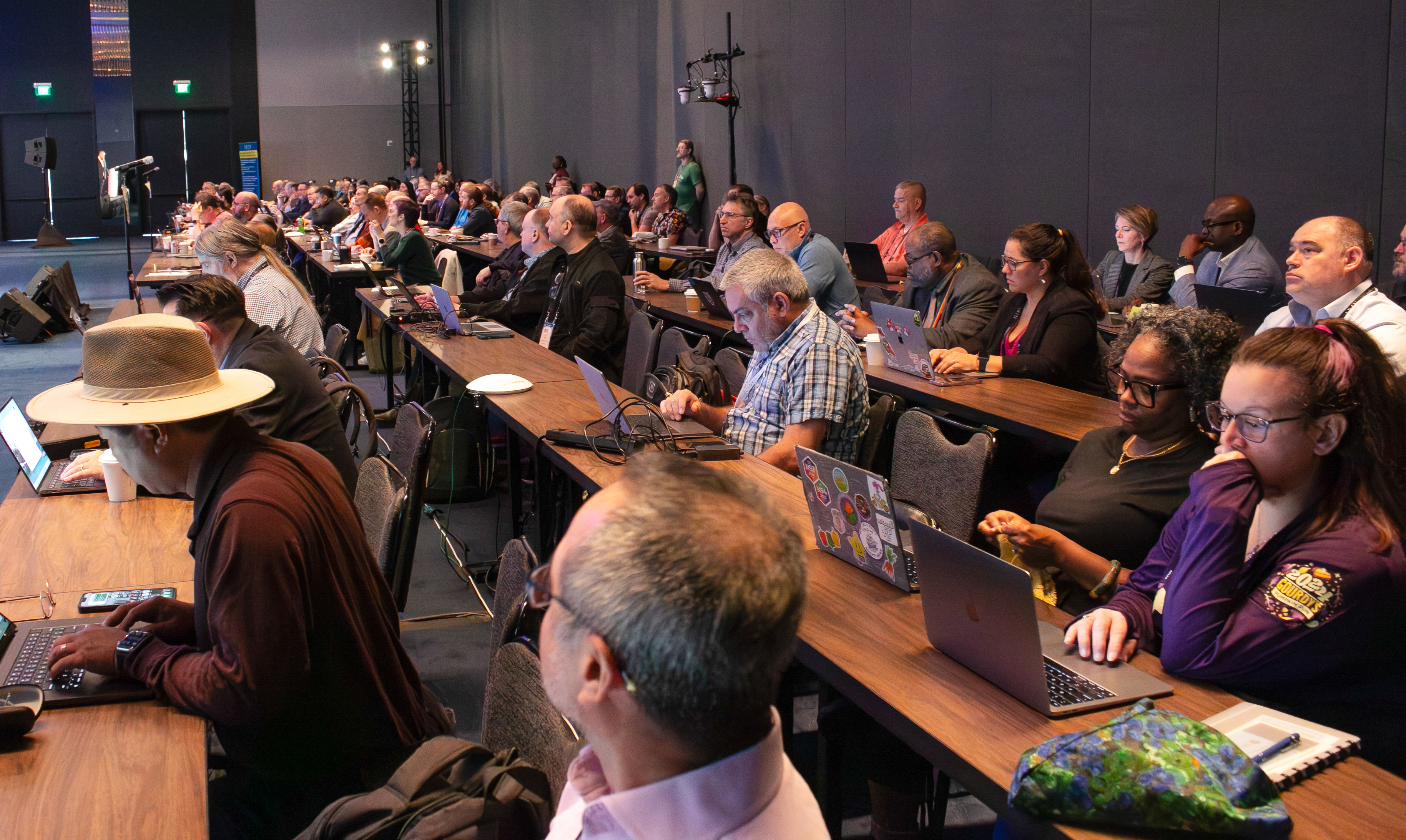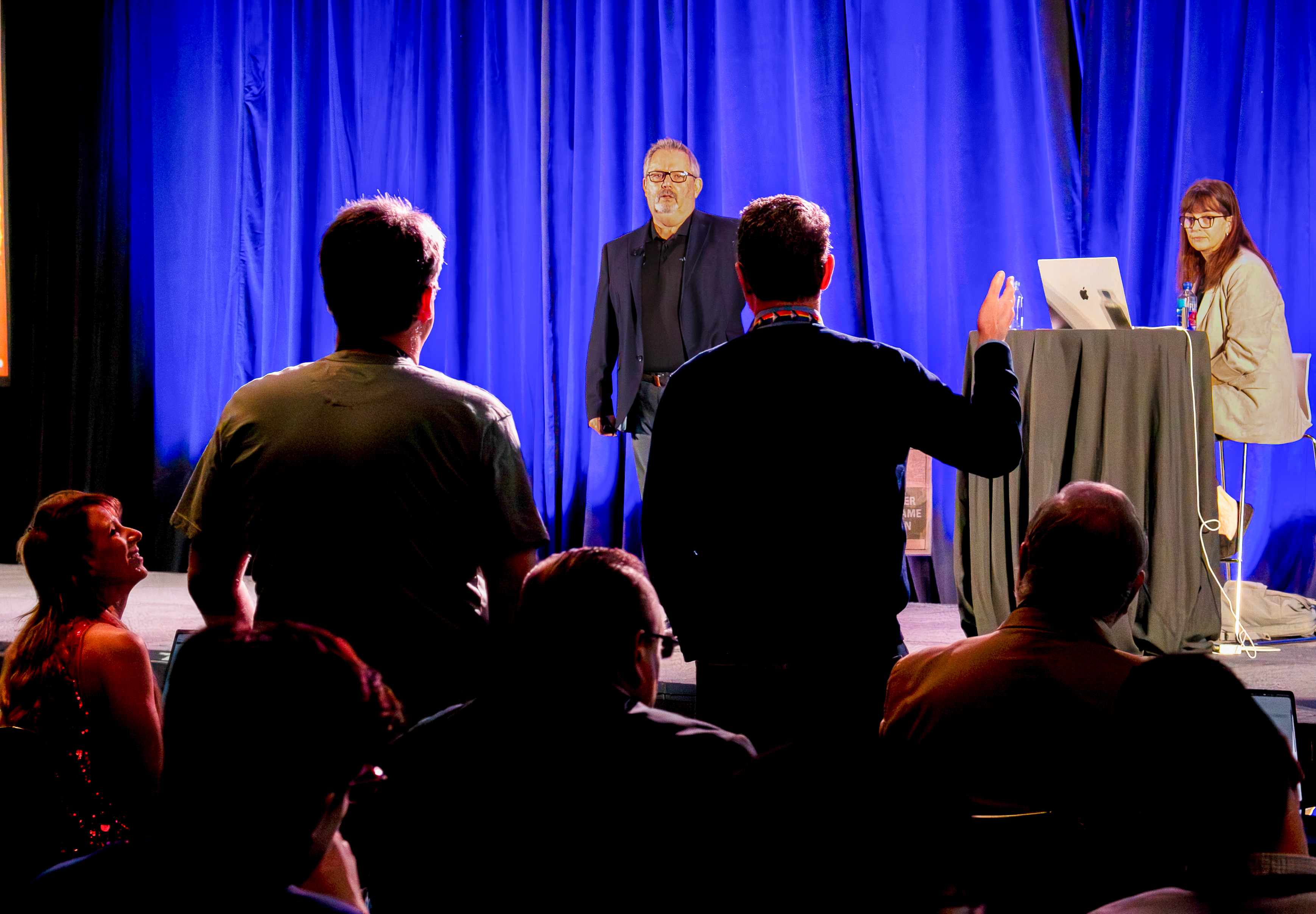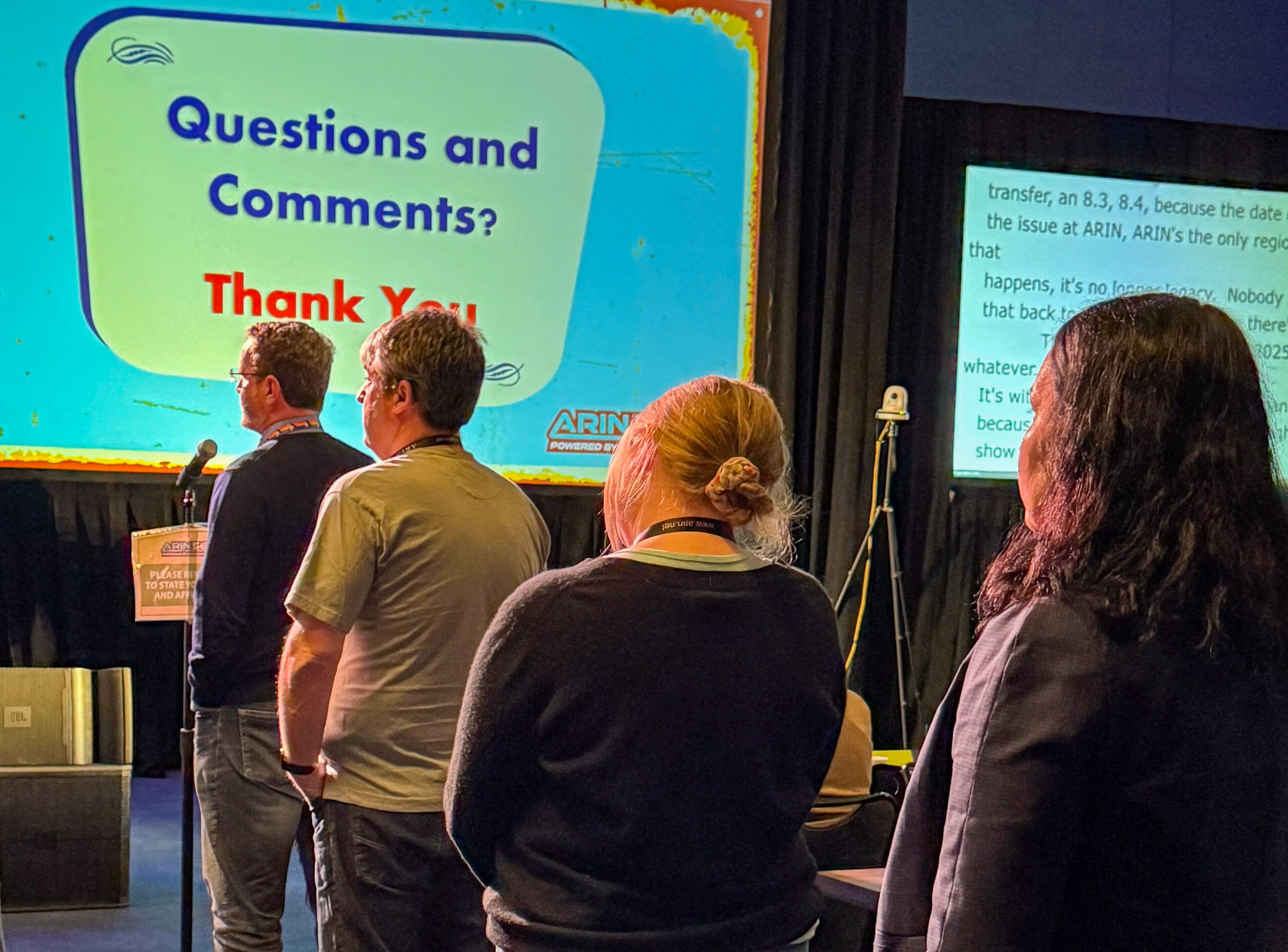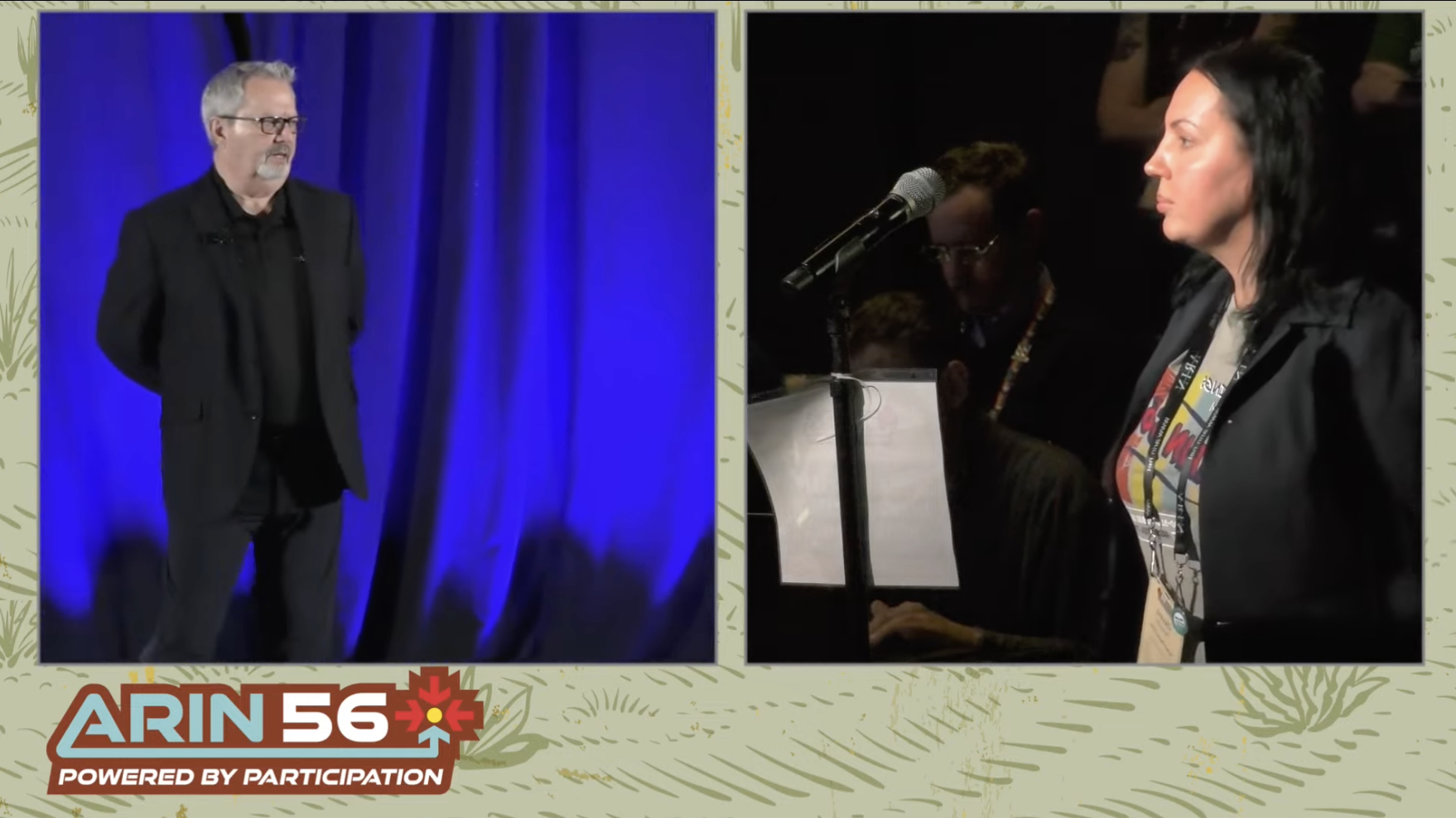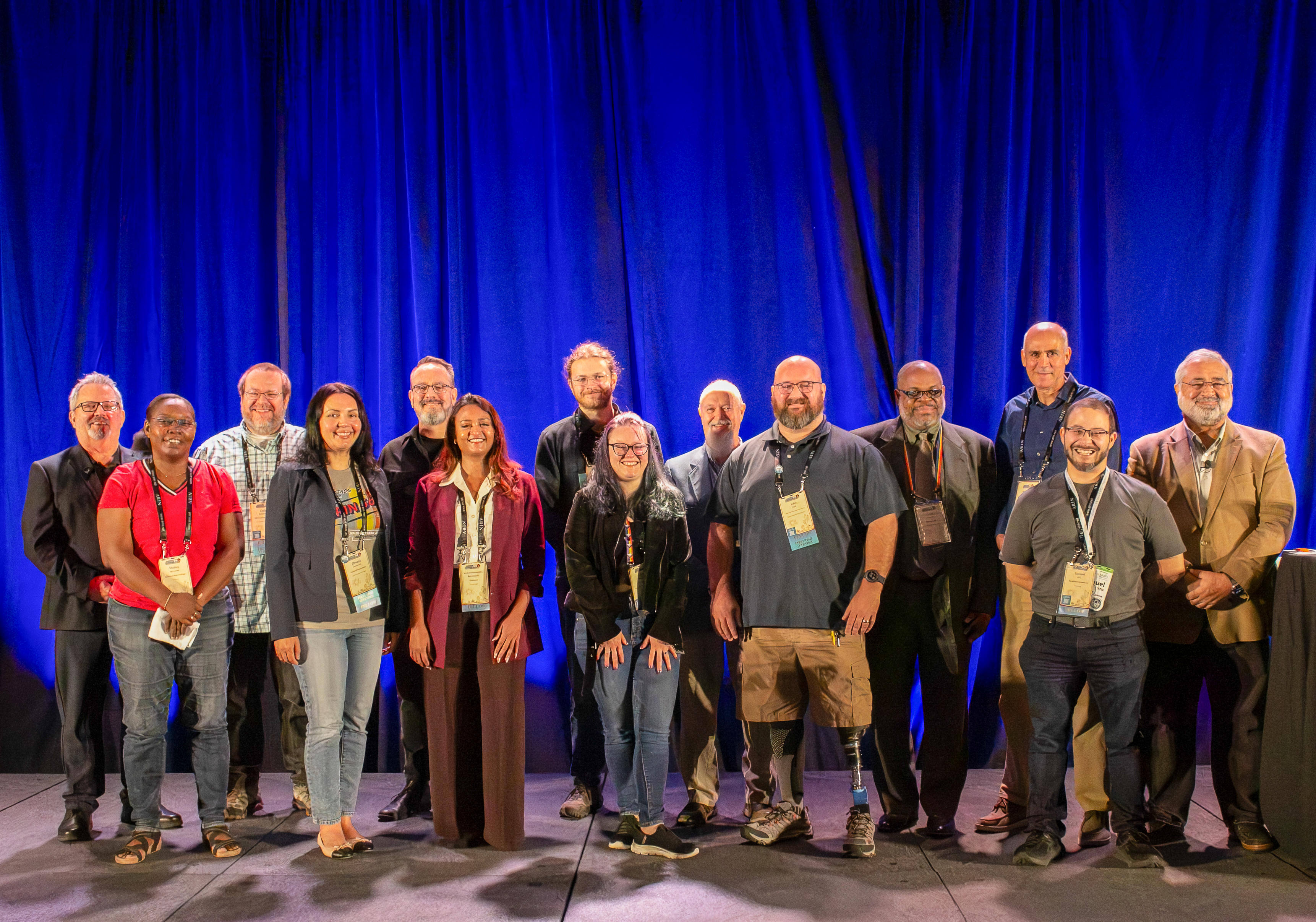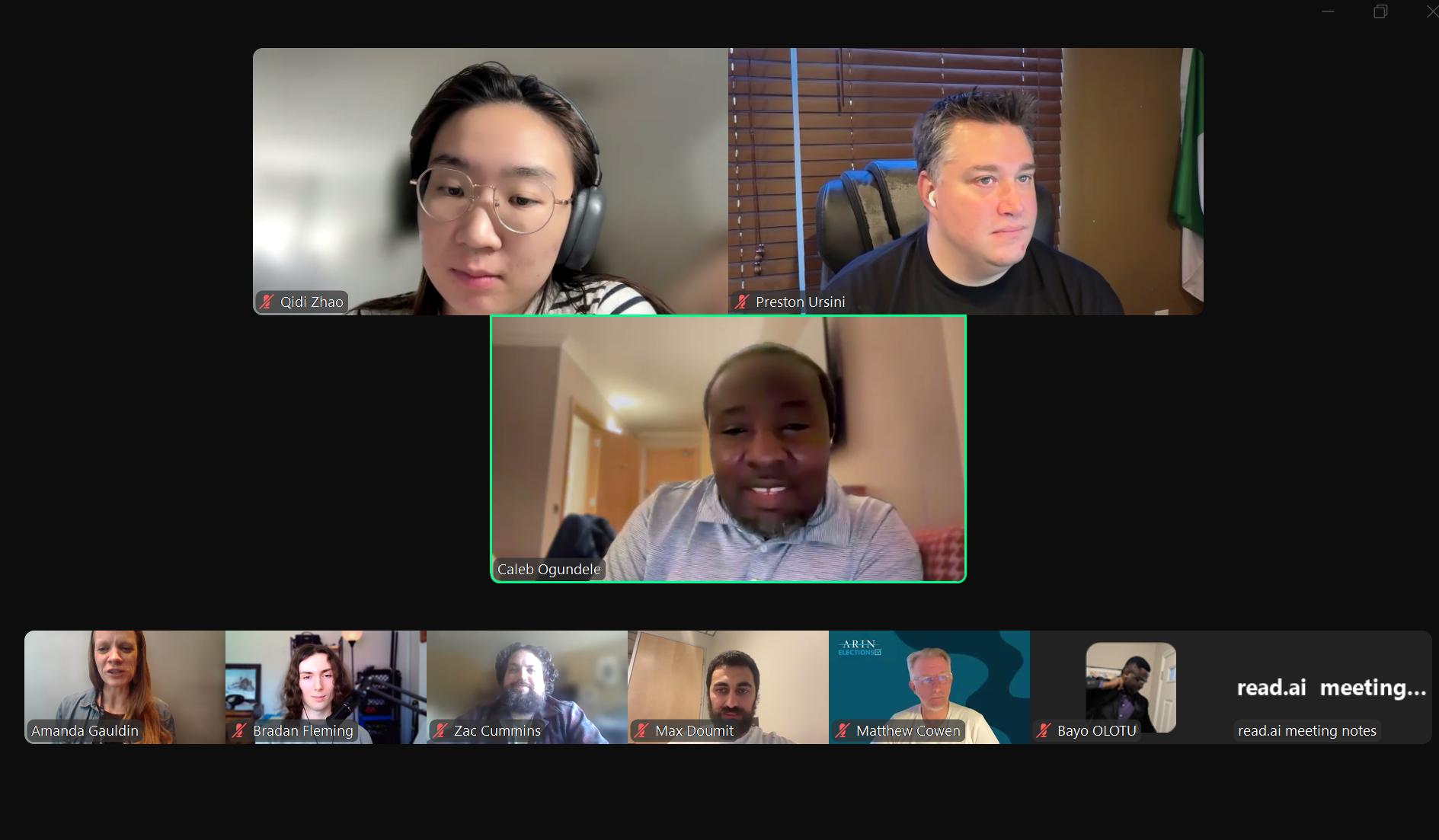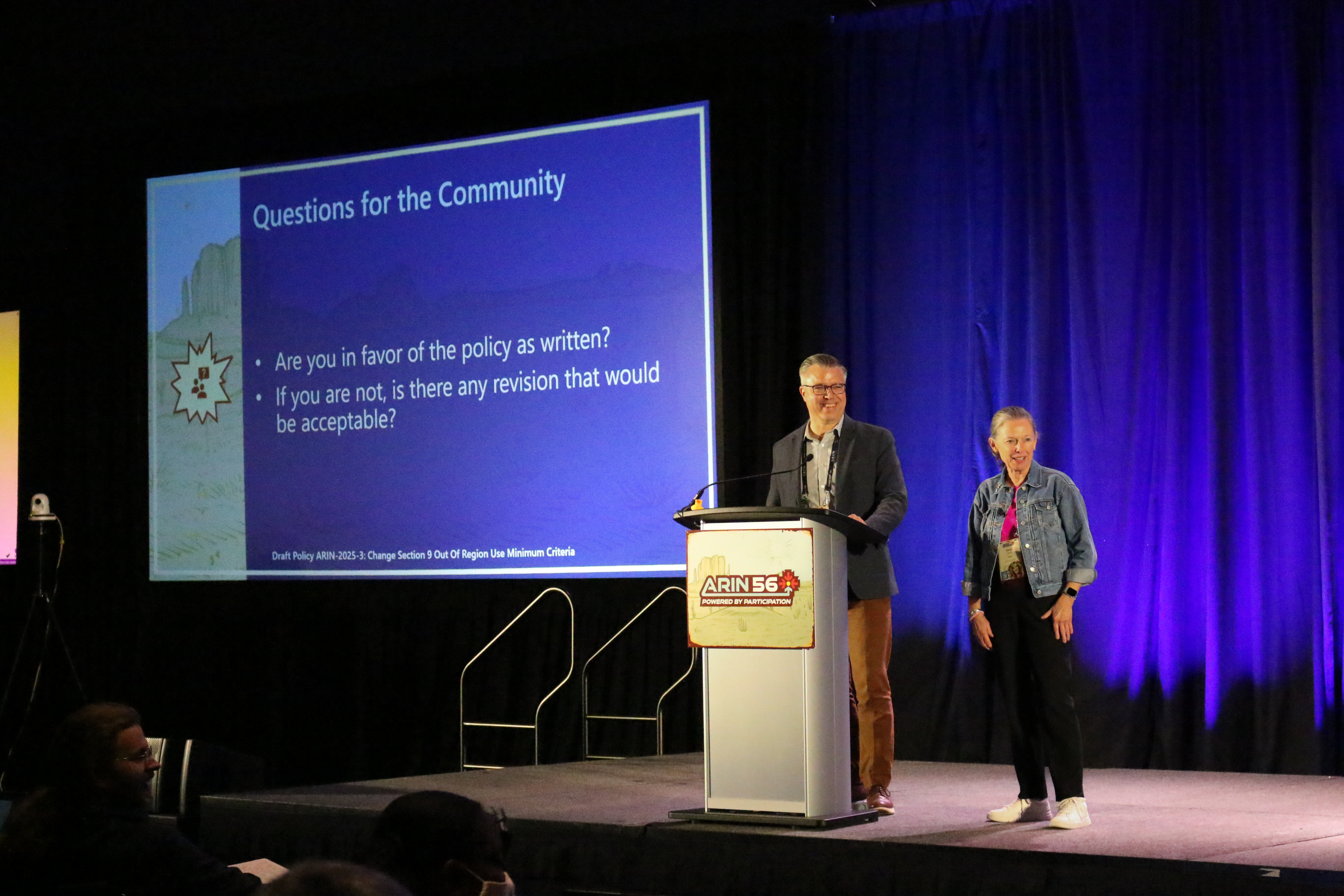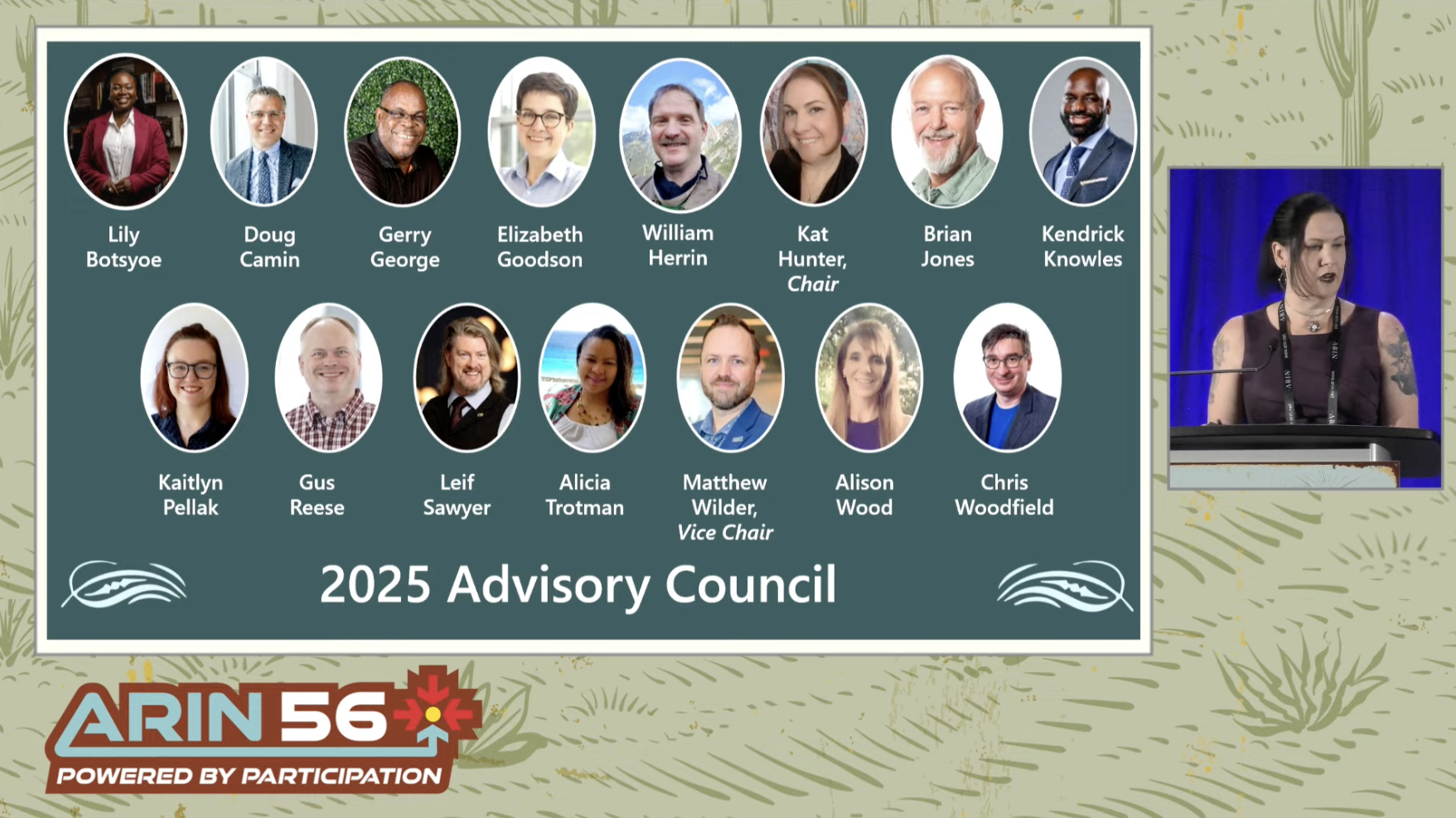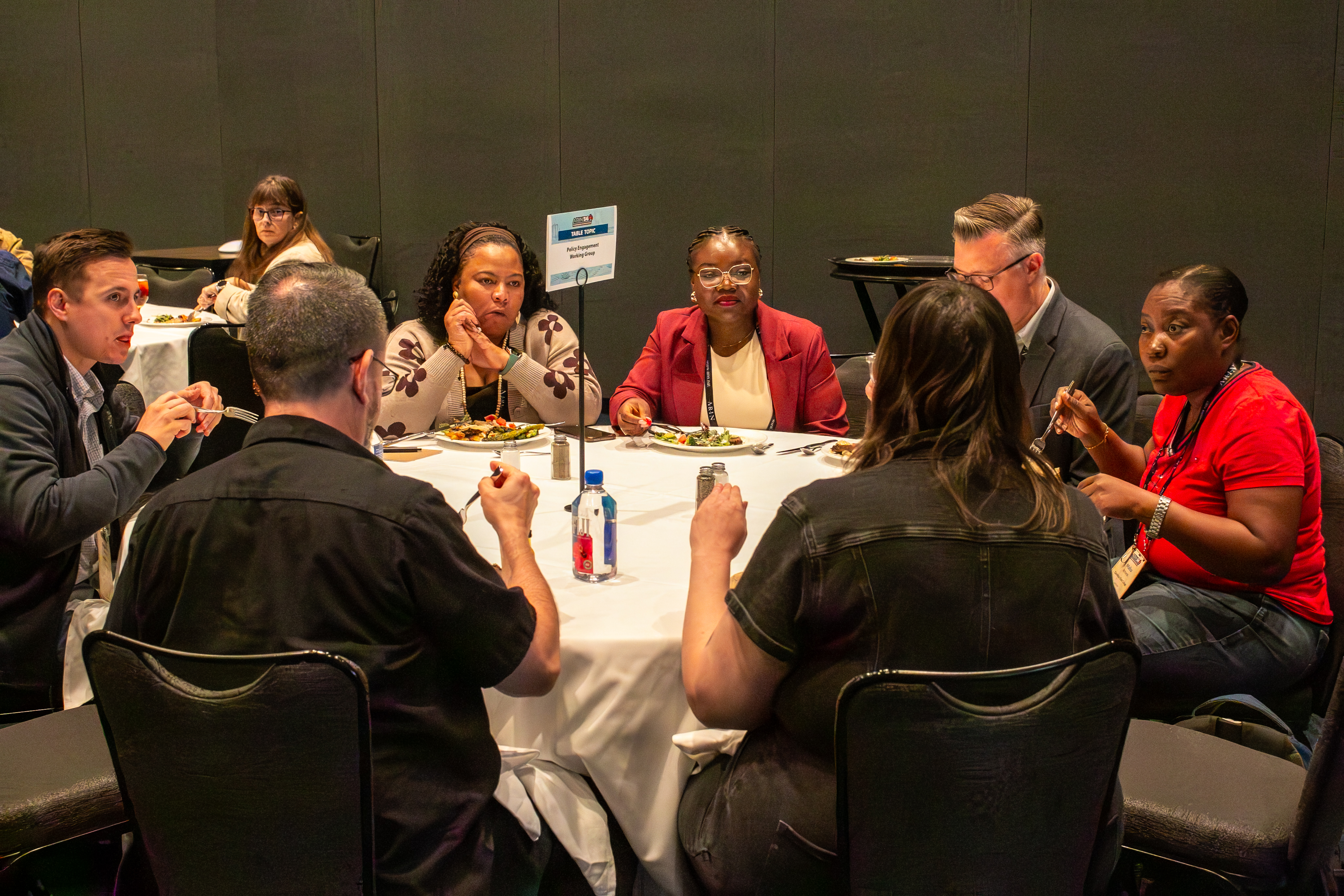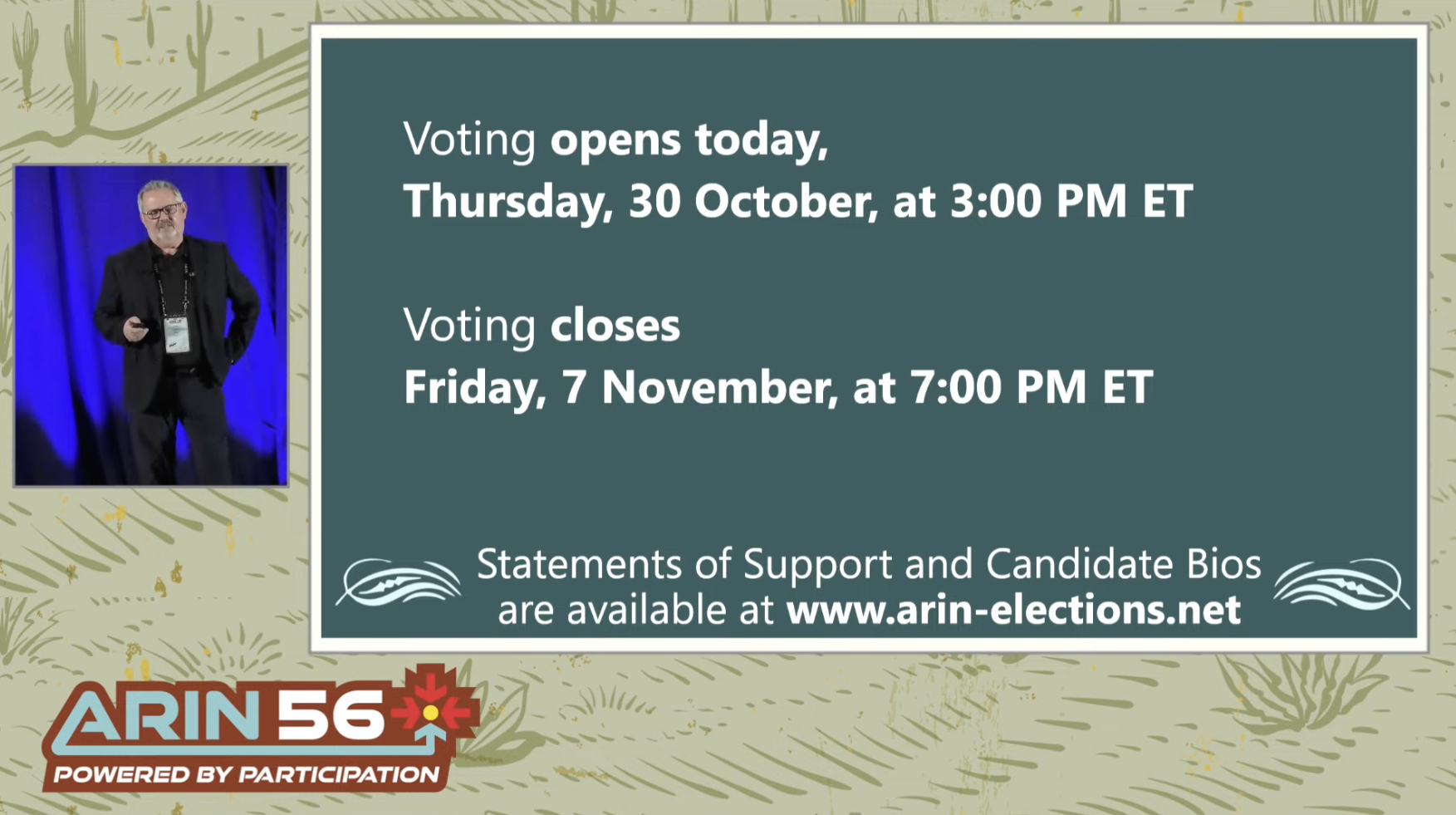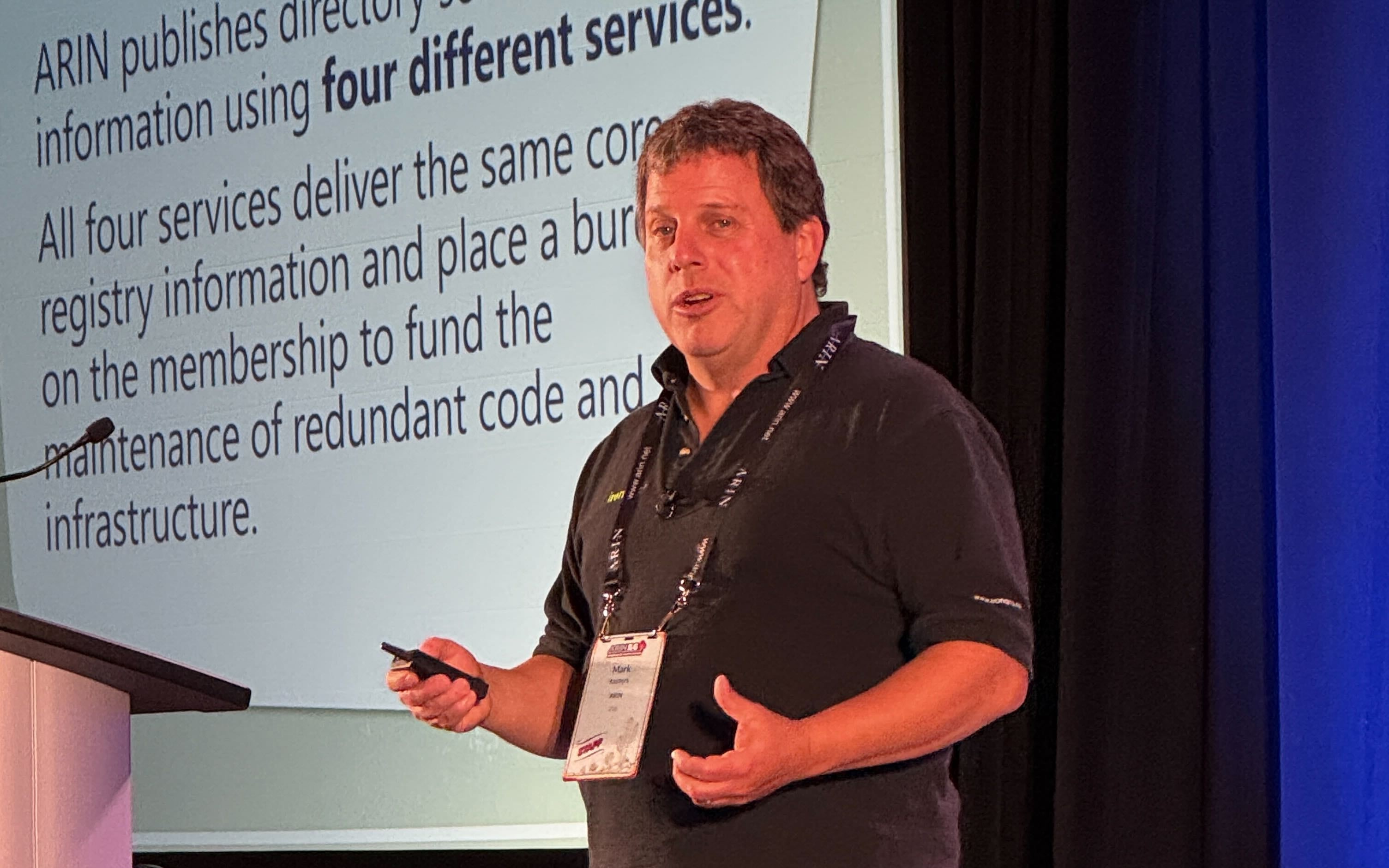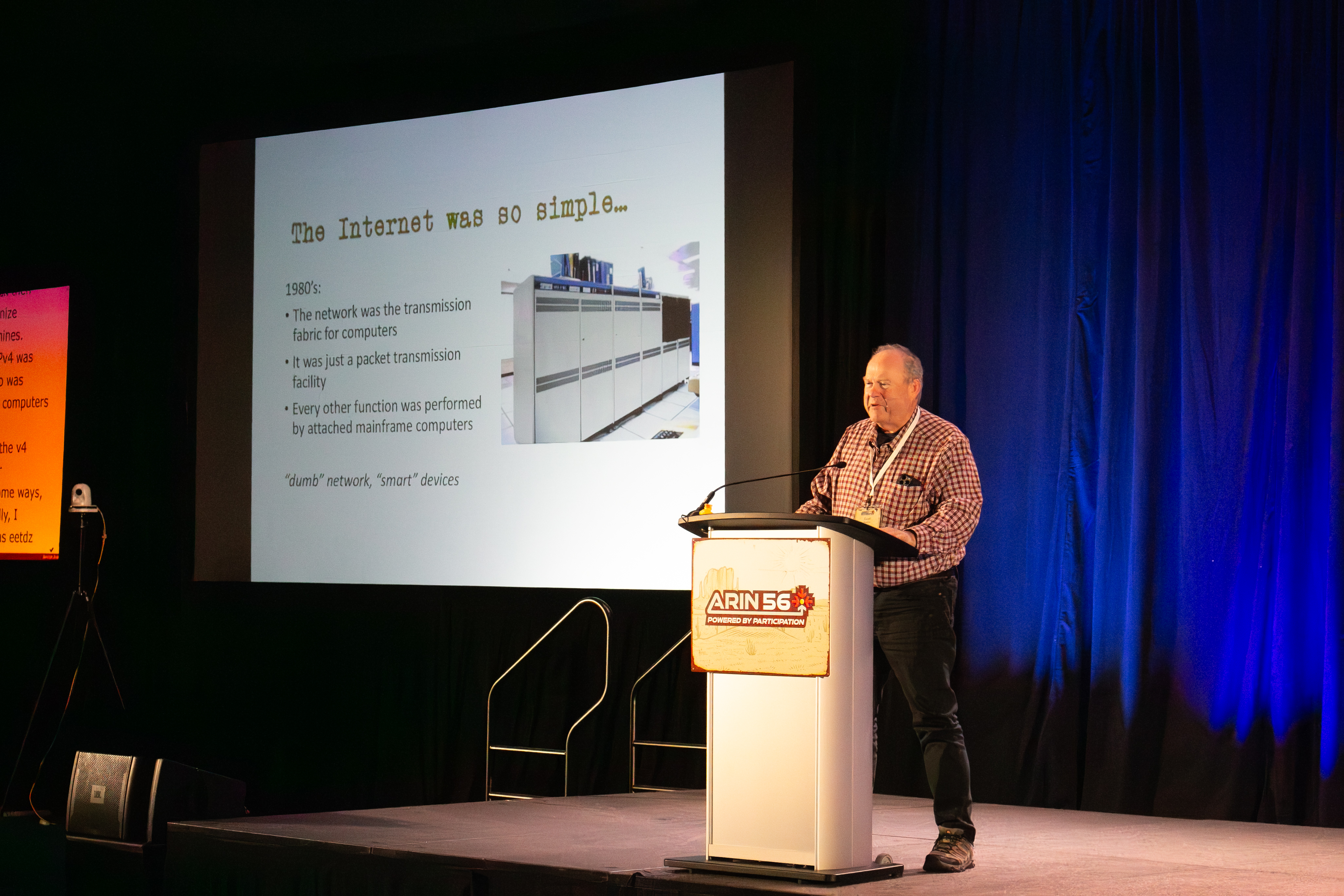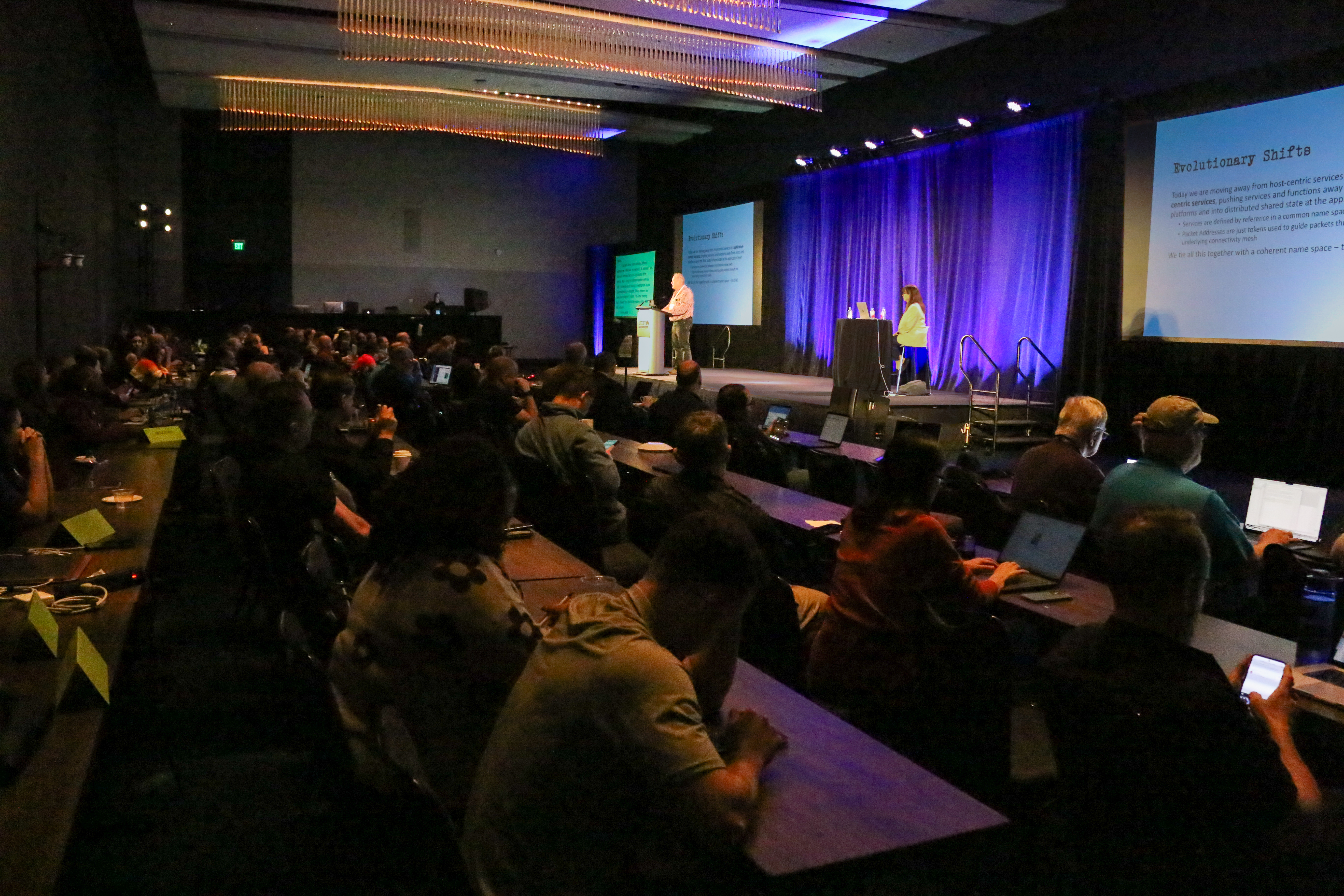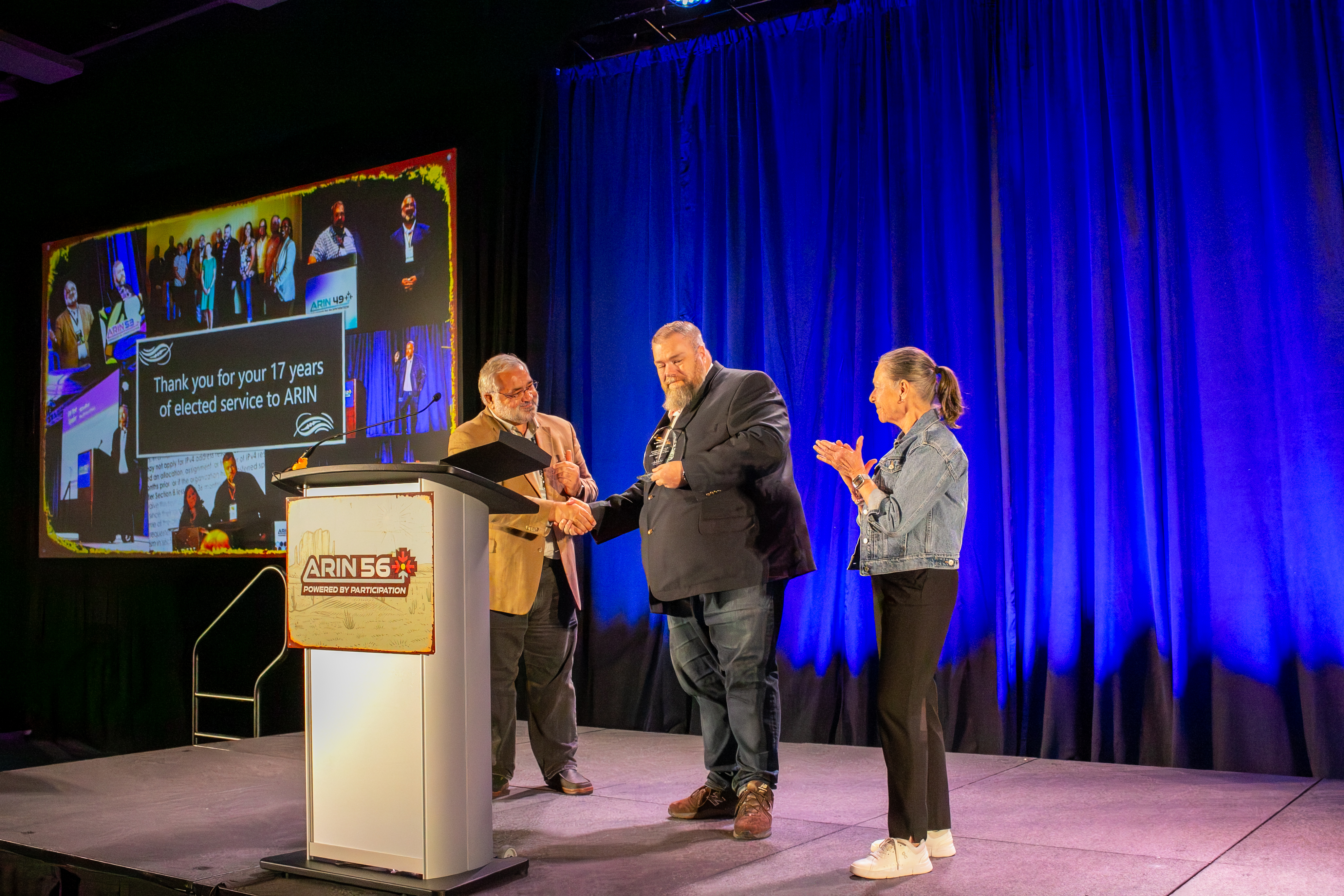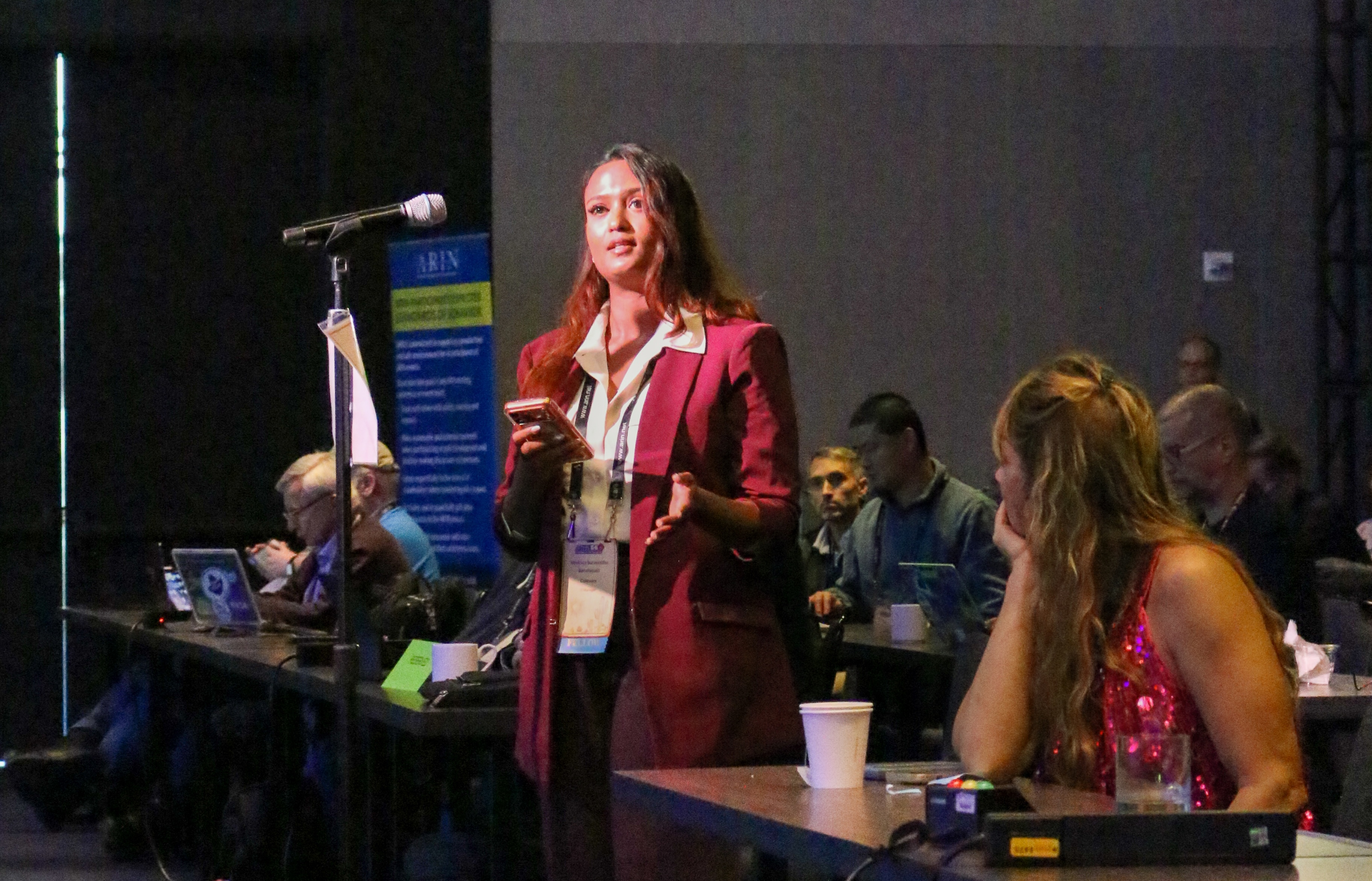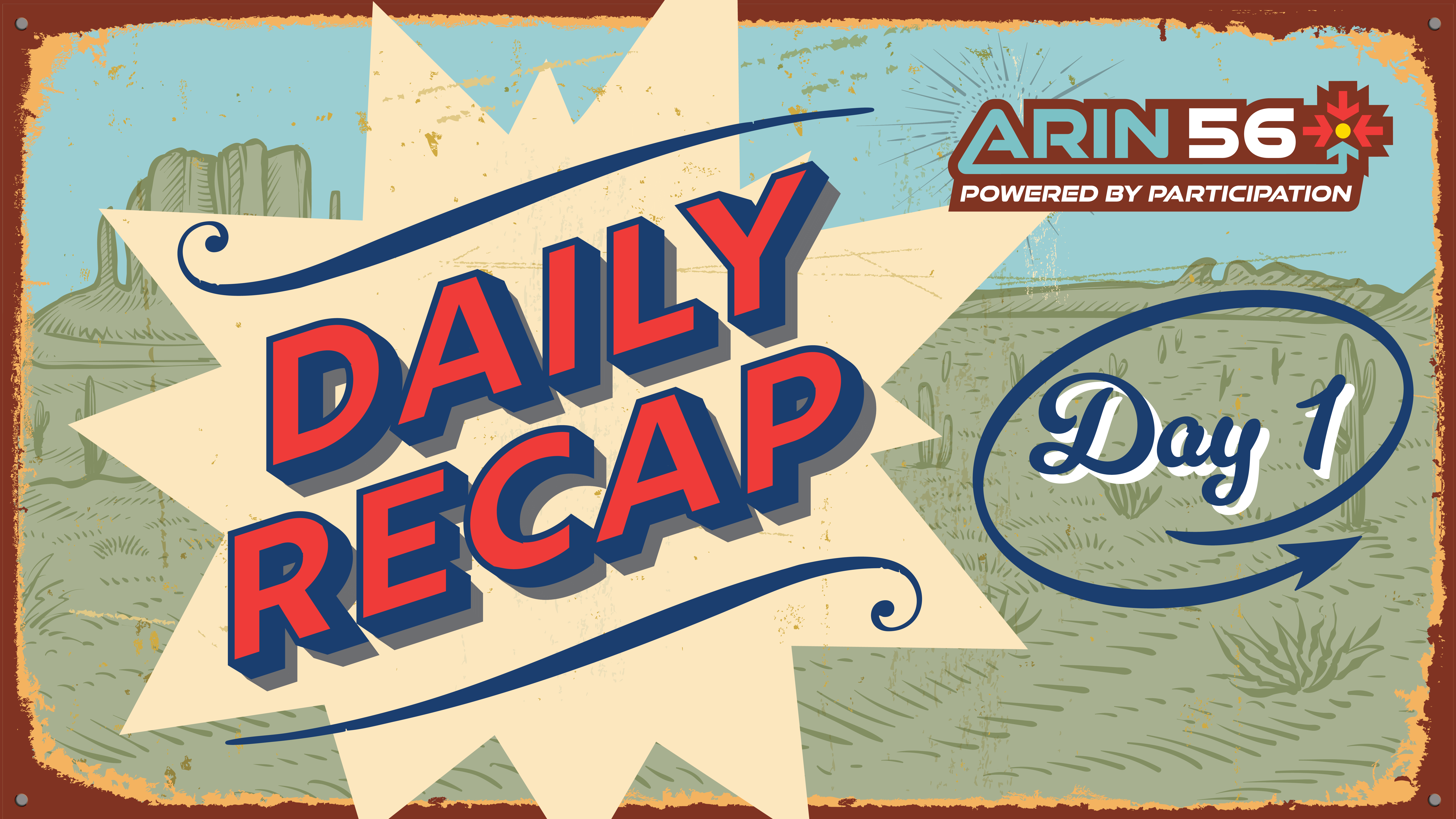
ARIN 56 Day 1 Recap
Howdy from Arlington, Texas, where the ARIN 56 Public Policy and Members Meeting began today. We’re delighted to welcome both new and established community members joining us in person and online for policy discussions, organizational updates, and more. Read on for a roundup of what has happened so far at ARIN 56.
Want to join in the discussions remotely? Register before tomorrow so we can invite you to the Zoom webinar.
Moseying On Over
This fall, the ARIN Fellowship Program once again included the opportunity for Fellows to take part in the NANOG conference directly preceding the ARIN meeting. The Fellows attending NANOG 95 had the chance to do some extra preparation for actively participating at ARIN 56 by networking with colleagues, establishing friendships, and learning from the discussions and presentations held Monday through Wednesday.
Then, on Wednesday evening, the wider group of ARIN 56 attendees joined in, greeting one another at an on-site Welcome Reception that provided a great opportunity to catch up before the busy meeting agenda began this morning.
Saddling Up
Thursday morning dawned clear and bright in Arlington as we began the first official day of the meeting. Hollis Kara, Director of Communications, started things off with the opening announcements, introductions of our Board of Trustees and Advisory Council (AC) and the Number Resource Organization Number Council (NRO NC), and an overview of the meeting agenda. She also offered thanks to our ARIN 56 network sponsor, AT&T; platinum sponsor, Amazon Web Services; social sponsor, Kalorama; silver sponsor, IPXO; and exhibitor sponsor IPv4.Global by Hilco Global, along with tips for both virtual and in-person attendees to make the most of their meeting experience.
Since ARIN 52, ARIN has been pleased to provide an ombudsperson during its meetings. Hollis reviewed ARIN’s values and Standards of Behavior then invited Wade Hinton, CEO and Founder of Hinton & Company, to introduce himself and explain his role as the ombudsperson in making the ARIN 56 meeting a safe and comfortable space for all participants.
Before getting into the morning’s presentations and updates, we heard opening remarks from John Curran, ARIN President and CEO, who highlighted the importance of these meetings as a forum for the development of number resource policy and encouraged attendees to engage in discussion and make good policy while having fun and connecting with each other to keep the community alive and well.
“If it weren’t for ARIN and the other RIRs, number resources would be managed by a process that wasn’t accessible,” he said. “You wouldn’t have a way of coming and getting Fellows to be introduced to the policy. You wouldn’t have people welcoming you to participate. You wouldn’t have the ability to discuss things in a forum that’s welcoming and everyone can share. And the fact of the matter is that the reason this is important is you’re managing the number resources. … It is an anchor of self-governance for the Internet.”
Rounding Up Community Updates
Bill Sandiford kicked off the day’s presentations with the Board of Trustees Report, which reviewed ARIN’s financial, fiduciary, and strategic planning actions along with an acknowledgement and thank you to the Board’s Committee Chairs. He specifically highlighted the Board’s adoption of a new Registration Services Agreement (RSA) intended to bring remaining legacy resources under agreement — noting that ARIN has already seen success from that effort — and its retention of an outside firm, Finley and Associates, to conduct a thorough review of ARIN’s strategic planning processes.
Before turning over the podium, Bill announced that he tendered his resignation as the Board Chair yesterday. Longtime Finance Committee Chair Nancy Carter was elected as the new Chair, making her the first female Chair of the ARIN Board. We offer our sincerest gratitude to Bill for his 12 years of service on the Board and congratulations to Nancy on her new leadership role!
NANOG Executive Director Jonathan Black then provided an update on NANOG governance, Program Committee activities, events, and community initiatives. He also emphasized the strong partnership between NANOG and ARIN, thanking ARIN for years of premium sponsorship that has helped make NANOG’s programs and conferences possible.
Policy Implementation and Experience
John Sweeting, Chief Experience Officer, gave the Policy Implementation and Experience Report that examined current practice, issues observed, and potential opportunities for changing procedures for: dedicated IPv4 allocations to facilitate IPv6 deployment (4.10); initial allocations to Internet service providers (4.2.2) and minimum assignments (4.3.2); and inter-RIR transfers.
John posed questions to the community about various aspects of ARIN’s number resource management policies and practices, inviting feedback on areas where the community’s guidance would help shape future operations. Community engagement with these topics was high, with John Sweeting and John Curran both responding to questions and comments from numerous in-person and virtual meeting participants. Be sure to view the presentation slides, livestream recording, and transcript to review all the questions and comments shared on these impactful topics — and then make your voice heard!
Join the discussion at the meeting or on our Public Policy mailing list (PPML).
Next up, James Mitchell, Director of IANA Technical Services, delivered the ICANN/IANA Update, covering IANA’s strategic plan, policy-driven priorities, website modernization, data publication enhancements, DNSSEC, and second-ever rollover of the Root Zone Key Signing Key.
Policy Discussion, Round One
After a stretch and snack break, Kat Hunter, AC Chair, then presented the AC Report and Docket. She introduced who and what the AC is, provided an overview of AC outreach activities and working groups, and summarized the policy activity since our last meeting, proposals received, and the items on the docket for the two policy sessions during ARIN 56.
With that, the first policy session began, and AC members presented each policy and then opened the floor for community input. Stepping into her new role as Board Chair, Nancy Carter hosted straw polls, and the meeting room and virtual chat engaged with robust questions, comments, and discussions on the three policies that hit the docket during this first round:
- Recommended Draft Policy ARIN-2024-5: Rewrite of NRPM Section 4.4 Micro-Allocation – presented by Chris Woodfield.
- Recommended Draft Policy ARIN-2025-2: Clarify 8.5.1 Registration Services Agreement – presented by Gus Reese.
- Draft Policy ARIN-2025-1: Clarify ISP and LIR Definitions and References to Address Ambiguity in NRPM Text – presented by Leif Sawyer
The enthusiastic discussion of these three policy proposals demonstrated the community’s commitment to shaping the future of Internet number resource management in the ARIN region.
Want to review previous versions of ARIN policies? Visit the Number Resource Policy Manual to access the Git Repository and the Change Log.
ARIN Elections
We broke for lunch to refuel and enjoy some time to chat with colleagues, including optional table topics hosted by AC members Lily Botsyoe, Alicia Trotman, Elizabeth Goodson, Brian Jones, William Herrin, Doug Camin, and Alison Wood — covering the Policy Engagement Working Group, out of region use, and the Section 6 IPv6 request formula.
With that, we entered the ARIN Elections portion of the program. First, John Sweeting provided an overview of how you can get to know the candidates, who can vote, and how and when to vote, including instructions for using the election system.
Then we watched recorded speeches from the candidates who are running for the ARIN Board and AC and the NRO NC this year. The candidates shared their visions for ARIN’s future, their qualifications, and their commitment to serving the community. It was inspiring to hear from so many dedicated individuals willing to step up and serve in volunteer leadership roles. You can view those speeches on the ARIN Elections website and on our YouTube channel.
Voting is now open and closes at 7:00 PM ET next Friday, 7 November. Be sure to cast your vote* and fulfill a vital community responsibility by helping shape the future of ARIN and the Internet as a whole!
With a little extra time to fill before the last items on the day’s agenda, Chief Technology Officer Mark Kosters stepped up to the podium to deliver an overview of ARIN’s directory services. He reviewed the four different services — Whois-Port 43, RWhois, Whois-RWS, and Whois — currently used to publish directory services information. All four services deliver the same core registry information and place a burden on the membership to fund the maintenance of redundant code and infrastructure; Mark reviewed how services can be simplified by retiring RWhois, Whois-RWS, and Whois. He also provided a comparison of Whois-RWS and RDAP along with a look at the state of Whois at Domain Registries.
Look for a forthcoming Community Consultation on the potential retirement of some of ARIN’s directory services; sign up for the ARIN Consultations mailing list so you can participate! We need your feedback to determine our path forward.
Policy Discussion, Round Two
Following a final break to keep the energy up through the end of the day, we rolled into the second policy session. AC members presented four additional Draft Policies and invited community input. Once again, both in-person and virtual attendees engaged in lively discussion of these policy proposals:
- Draft Policy ARIN-2025-3: Change Section 9 Out Of Region Use Minimum Criteria – presented by Doug Camin
- Draft Policy ARIN-2025-6: Fix Formula in 6.5.2.1c – presented by the William Herrin
- Draft Policy ARIN-2025-7: Make Policy in 6.5.8.2 Match the Examples – presented by Lily Botsyoe
- Draft Policy ARIN-2025-8: Reserve 4.10 space for In-Region Use – presented by Kaitlyn Pellak
The depth and breadth of community engagement throughout both policy sessions demonstrated the strength of ARIN’s bottom-up, community-driven policy development process. Meeting participants raised thoughtful questions, shared diverse perspectives, and provided direction to help drive the future of proposals that will shape Internet number resource management.
Internet Evolution and IPv6
Having rolled right on through our agenda, we had time to add in a special guest presentation from Geoff Huston, Chief Scientist at APNIC, before closing out the day with an open microphone session. Goeff delivered a thought-provoking exploration of Internet evolution and IPv6, tracing the transformation from simple 1980s packet networks to today’s complex infrastructure. He explained how the shift from scarcity to abundance in capacity and compute power enabled the “just in case” provisioning model, making services bigger, faster, and cheaper. However, Huston highlighted a critical challenge: While network capacity scales exponentially, processor speeds have plateaued, creating a growing complexity burden. He argued that IPv6 deployment is essential for reducing this complexity and enabling affordable, secure scaling — a reality reflected in dramatic IPv6 adoption in India and China.
Questions, Comments, and Commemoration
Throughout the day, attendees had the opportunity to ask questions and provide feedback at an on-site Registration Services Help Desk and a virtual ARIN Elections Help Desk hosted by ARIN staff. And before the meeting wrapped up for the evening, John Curran and Nancy Carter hosted an open microphone session for community members to pose questions or comments on any topic.
Comments and questions hit on topics ranging from the qualification status of candidates running for the AC, the opportunity for ARIN to experiment with AI and automation to transform operations, and transparency of operational data.
Before leaving the stage, John Curran presented Bill Sandiford with a commemorative plague in recognition of his 17 years of elected service with ARIN. Hollis Kara then closed with final announcements, another round of thanks for the meeting sponsors, and adjournment.
Day 1, Done!
With that, day one of ARIN 56 was in the books. Now we’re off to the ARIN Social tonight where we will network with our fellow meeting attendees at the home of the Dallas Cowboys, AT&T Stadium.
If you would like to refer to anything you have seen (or missed) so far, all slides from today have been posted online on our ARIN 56 Meeting Materials page, and, over the next few days, we’ll also add links to the full transcript and webcasts.
We’ll see you back here tomorrow for the second and final day of ARIN 56. Don’t forget to use the #ARIN56 hashtag and tag us @arin_rir on Instagram, @TeamARIN on X and Facebook and @ARIN on LinkedIn when sharing about your meeting experience on social media!
Taking photos or screenshots of your ARIN 56 experience? We’d love to share them with the community! Tag, reply, comment, or message us on social media or email us at social@arin.net with images (and photo credit, if needed) that you grant us permission to publish online.
*Organizations may submit a blank ballot. Your participation in the elections will still be recorded, and the organization will maintain General Member status.
Recent blogs categorized under: Public Policy
GET THE LATEST!
Sign up to receive the latest news about ARIN and the most pressing issues facing the Internet community.
SIGN ME UP →Blog Categories
Updates • Outreach • Internet Governance • Grant Program • Tips • RPKI • IRR • IPv6 • Public Policy • Caribbean • Elections • ARIN Bits • Fellowship Program • Training • Security • Guest Post • Data Accuracy • Business Case for IPv6 • IPv4 • Customer Feedback



